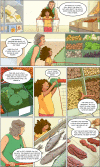The use of comics to promote health awareness: A template using nonalcoholic fatty liver disease
- PMID: 34159578
- PMCID: PMC9285735
- DOI: 10.1111/eci.13642
The use of comics to promote health awareness: A template using nonalcoholic fatty liver disease
Abstract
Nonalcoholic fatty liver disease (NAFLD) constitutes a major threat to public health systems worldwide on account of its widespread prevalence and increasing incidence. More effective tools to raise awareness and increase health communication are therefore needed. Comics may constitute an effective language for this purpose, given the permanence, adaptability and ability of this form of communication to convey complex information, using both visual components and the creation of narrative involvement, thus promoting both awareness and health-conscious behaviours. Importantly, this process requires careful preparation in terms of selecting both the key biomedical concepts to be conveyed, as well as a graphical style and appropriate characters and a narrative arc with which a target audience can identify with. Here we provide a brief introduction to the use of comics in health communication and propose a possible roadmap for the development of comic-based tools for diverse conditions, using the context of NAFLD.
Keywords: NAFLD; biomedical knowledge; comics; health communication.
© 2021 The Authors. European Journal of Clinical Investigation published by John Wiley & Sons Ltd on behalf of Stichting European Society for Clinical Investigation Journal Foundation.
Conflict of interest statement
None of the authors have potential conflicts of interest to be disclosed.
Figures




References
-
- Corbin J, Strauss A. Basics of Qualitative Research: Techniques and Procedures for Developing Grounded Theory. Thousand Oaks, CA: Sage; 2015.
-
- Anstee QM, Reeves HL, Kotsiliti E, Govaere O, Heikenwalder M. From NASH to HCC: current concepts and future challenges. Nat Rev Gastroenterol Hepatol. 2019;16(7):411‐428. - PubMed
-
- Younossi ZM, Koenig AB, Abdelatif D, Fazel Y, Henry L, Wymer M. Global epidemiology of nonalcoholic fatty liver disease—Meta‐analytic assessment of prevalence, incidence, and outcomes. Hepatology. 2016;64(1):73‐84. - PubMed
Publication types
MeSH terms
Grants and funding
LinkOut - more resources
Full Text Sources
Medical

